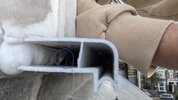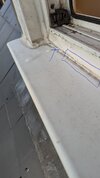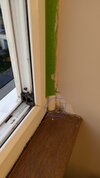Hi,
I'm getting damp at one corner of a uPVC window and trying to figure out where the water is coming from. We had a new roof installed above the window, and the roofers have been back twice to check that the water isn't coming from above and they confirmed it's all sealed. From what I can tell there might be two sources:
1. The roofers sealed the bottom of the window - I believe that's where drainage is meant to come out - but I tried (and failed) to remove the sealant!
2. The edge of the window cill isn't closed off or sealed - is it meant to be? I could see inside and it does look like water could potentially make its way in that way
Have attached some pics - Thanks!
I'm getting damp at one corner of a uPVC window and trying to figure out where the water is coming from. We had a new roof installed above the window, and the roofers have been back twice to check that the water isn't coming from above and they confirmed it's all sealed. From what I can tell there might be two sources:
1. The roofers sealed the bottom of the window - I believe that's where drainage is meant to come out - but I tried (and failed) to remove the sealant!
2. The edge of the window cill isn't closed off or sealed - is it meant to be? I could see inside and it does look like water could potentially make its way in that way
Have attached some pics - Thanks!





